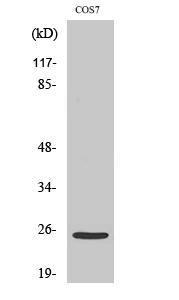Cleaved-Integrin α7 LC (E959) Cell-Based Colorimetric ELISA Kit
- Catalog No.:KA3962C
- Applications:ELISA
- Reactivity:Human
- Gene Name:
- ITGA7
- Human Gene Id:
- 3679
- Human Swiss Prot No:
- Q13683
- Mouse Swiss Prot No:
- Q61738
- Storage Stability:
- 2-8°C/6 months
- Other Name:
- Integrin alpha-7 [Cleaved into: Integrin alpha-7 heavy chain;Integrin alpha-7 light chain;Integrin alpha-7 70 kDa form]
- Detection Method:
- Colorimetric
- Background:
- alternative products:Additional isoforms seem to exist. There is a combination of at least five alternatively spliced domains, three extracellular (X1, X2 and D) and two cytoplasmic (A and B). A third potential alternatively spliced cytoplasmic domain (C) does not appear to be expressed. In vitro generated isoform X2C shows function. So far detected are isoform Alpha-7X1A, isoform Alpha-7X2B (major), isoform Alpha-7X2DB (minor) and minor isoforms containing segment X1X2. Experimental confirmation may be lacking for some isoforms,developmental stage:In renewing intestinal epithelium, expression of isoforms containing segment B correlates with the onset of enterocytic differentiation.,disease:Defects in ITGA7 are associated with a form of congenital myopathy; a group of heterogeneous muscle disorders which are thought to result from abnormal muscle development. Muscle weakness is either non-progressive or slowly progressive and apparent from birth or early infancy.,function:Integrin alpha-7/beta-1 is the primary laminin receptor on skeletal myoblasts and adult myofibers. During myogenic differentiation, it may induce changes in the shape and mobility of myoblasts, and facilitate their localization at laminin-rich sites of secondary fiber formation. It is involved in the maintenance of the myofibers cytoarchitecture as well as for their anchorage, viability and functional integrity. Isoform Alpha-7X2B and isoform Alpha-7X1B promote myoblast migration on laminin 1 and laminin 2/4, but isoform Alpha-7X1B is less active on laminin 1 (In vitro).,PTM:ADP-ribosylated on at least two sites of the extracellular domain in skeletal myotubes.,similarity:Belongs to the integrin alpha chain family.,similarity:Contains 7 FG-GAP repeats.,subunit:Heterodimer of an alpha and a beta subunit. The alpha subunit is composed of an heavy and a light chain linked by a disulfide bond. Alpha-7 associates with beta-1.,tissue specificity:Isoforms containing segment A are predominantly expressed in skeletal muscle. Isoforms containing segment B are abundantly expressed in skeletal muscle, moderately in cardiac muscle, small intestine, colon, ovary and prostate and weakly in lung and testes. Isoforms containing segment X2D are expressed at low levels in fetal and adult skeletal muscle and in cardiac muscle, but are not detected in myoblasts and myotubes. In muscle fibers isoforms containing segment A and B are expressed at myotendinous and neuromuscular junctions; isoforms containing segment C are expressed at neuromuscular junctions and at extrasynaptic sites. Isoforms containing segments X1 or X2 or, at low levels, X1X2 are expressed in fetal and adult skeletal muscle (myoblasts and myotubes) and cardiac muscle.,
- Function:
- blood vessel development, vasculature development, cell adhesion, cell-matrix adhesion, cell surface receptor linked signal transduction, integrin-mediated signaling pathway, muscle organ development, regulation of cell shape,regulation of cell morphogenesis, biological adhesion, cell-substrate adhesion, blood vessel morphogenesis,
- Subcellular Location:
- Membrane; Single-pass type I membrane protein.
- Expression:
- Isoforms containing segment A are predominantly expressed in skeletal muscle. Isoforms containing segment B are abundantly expressed in skeletal muscle, moderately in cardiac muscle, small intestine, colon, ovary and prostate and weakly in lung and testes. Isoforms containing segment X2D are expressed at low levels in fetal and adult skeletal muscle and in cardiac muscle, but are not detected in myoblasts and myotubes. In muscle fibers isoforms containing segment A and B are expressed at myotendinous and neuromuscular junctions; isoforms containing segment C are expressed at neuromuscular junctions and at extrasynaptic sites. Isoforms containing segments X1 or X2 or, at low levels, X1X2 are expressed in fetal and adult skeletal muscle (myoblasts and myotubes) and cardiac muscle.
- June 19-2018
- WESTERN IMMUNOBLOTTING PROTOCOL
- June 19-2018
- IMMUNOHISTOCHEMISTRY-PARAFFIN PROTOCOL
- June 19-2018
- IMMUNOFLUORESCENCE PROTOCOL
- September 08-2020
- FLOW-CYTOMEYRT-PROTOCOL
- May 20-2022
- Cell-Based ELISA│解您多样本WB检测之困扰
- July 13-2018
- CELL-BASED-ELISA-PROTOCOL-FOR-ACETYL-PROTEIN
- July 13-2018
- CELL-BASED-ELISA-PROTOCOL-FOR-PHOSPHO-PROTEIN
- July 13-2018
- Antibody-FAQs



